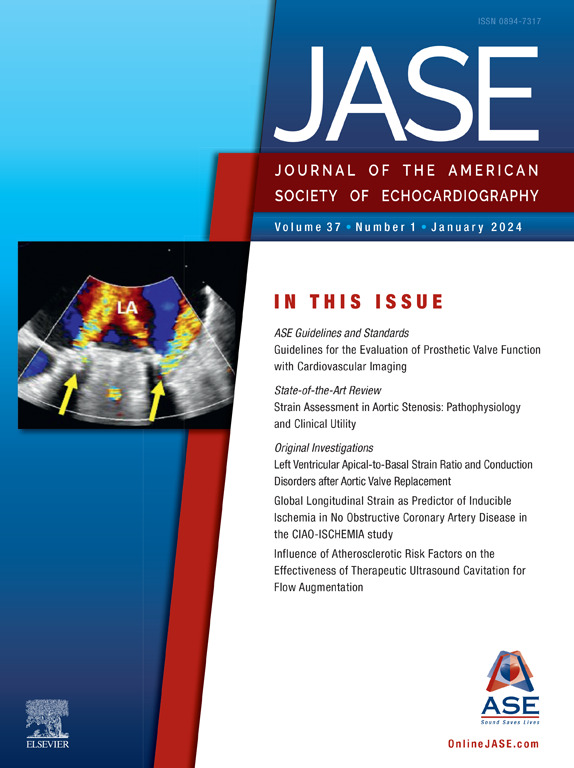Acute Maternal Hyperoxygenation to Predict Hypoxia and Need for Emergency Intervention in Fetuses With Transposition of the Great Arteries: A Pilot Study
IF 6
2区 医学
Q1 CARDIAC & CARDIOVASCULAR SYSTEMS
Journal of the American Society of Echocardiography
Pub Date : 2025-04-01
DOI:10.1016/j.echo.2024.12.011
引用次数: 0
Abstract
Background
Newborns with transposition of the great arteries (TGA) are at risk of severe hypoxia from inadequate atrial mixing, closure of the arterial duct, and/or persistent pulmonary hypertension of the newborn (PPHN). Acute maternal hyperoxygenation (AMH) might assist in identifying at-risk fetuses. We report pulmonary vasoreactivity to AMH in TGA fetuses and its relationship to early postnatal hypoxia and requirement for emergency balloon atrial septostomy (e-BAS).
Methods
Standard fetal echocardiographic (FE) assessment of the foramen ovale (FO): to total septal length and morphology of flap valve of the FO were used to predict the need for e-BAS. Following prospective recruitment, additional assessments were performed in fetuses with TGA at baseline and repeated after 10 minutes of 10 L/min of 100% oxygen delivered via non-rebreather mask to the pregnant mother. Analysis included measurement of atrial septal excursion, branch pulmonary artery pulsatility index (PA PI), middle cerebral artery (MCA) PI, and cardiac output. Delivery and newborn status were reviewed. Hypoxia was defined as preductal oxygen saturations <75% and e-BAS when undertaken within 2 hours of birth. Area under receiver operating characteristics curves were calculated.
Results
Thirty cases underwent FE at 34.6 weeks’ gestation (interquartile range, 34.6-35.6). All 7 predicted to require e-BAS based on standard FE were correctly identified prenatally. Three of 30 were hypoxic without FO restriction and treated with nitric oxide (PPHN). Change in PA PI ≤ 15% was associated with PPHN (P = .001) but not with e-BAS. The MCA PI response to AMH varied according to newborn condition, a mean reduction occurred in the non-hypoxic newborns (−7.8 ± 18.3, P = .05). Increase in MCA PI Z score (area under receiver operating characteristics curves; 0.837; 95% CI, 0.663-1.00, P = .01), reduction in right ventricular cardiac output (0.811; 95% CI, 0.623-0.998, P = .04), and reduction in combined cardiac output (0.851; 95% CI, 0.699-1.0, P = .01) were moderately associated with e-BAS. Changes in atrial septal excursion and FO flow direction with AMH did not correlate with newborn condition.
Conclusions
A PA PI change ≤15% to AMH was associated with postnatal hypoxia due to PPHN. Increase in right and combined cardiac output and reduced MCA resistance with AMH are seen in those who do not require e-BAS.
急性母体高氧预测缺氧和需要紧急干预胎儿大动脉转位:一项试点研究。
背景:新生儿大动脉转位(TGA)有严重缺氧的风险,包括心房混合不充分、动脉导管闭合和/或肺动脉高压(PPHN)。急性母体高氧(AMH)可能有助于识别高危胎儿。我们报道TGA胎儿对AMH的肺血管反应性及其与产后早期缺氧和紧急气囊房间隔造口术(e-BAS)需求的关系。方法:标准胎儿超声心动图(FE)评估卵圆孔(FO):用总间隔长度和FO瓣瓣形态来预测是否需要进行e-BAS。在前瞻性招募后,在基线时对TGA胎儿进行了额外的评估,并在10分钟后通过无呼吸面罩向孕妇输送10L/min的100%氧气后重复。分析包括房间隔偏移、肺动脉支脉搏指数(PA-PI)、大脑中动脉(MCA) PI和心输出量的测量。回顾了分娩和新生儿状况。结果:30例在妊娠34.6周(IQR: 34.6 ~ 35.6)行FE。根据标准FE预测需要e-BAS的7例患者在产前均被正确识别。其中3/30为缺氧,不限制FO,用一氧化氮(PPHN)处理。PA-PI < 15%的变化与PPHN相关(p=0.001),但与e-BAS无关。AMH的MCA-PI反应因新生儿情况而异,非缺氧新生儿平均降低(-7.8±18.3,p=0.05)。MCA-PI Z评分升高AUROC 0.837 (95% CI: 0.663-1.00, p=0.01);右心室心输出量减少0.811 (95% CI: 0.623-0.998, p=0.04),合并心输出量减少0.851 (95% CI: 0.699-1.0, p=0.01)与e-BAS中度相关。房间隔偏移和左心室血流方向的改变与新生儿状况无关。结论:PA-PI变化< 15%至AMH与PPHN所致的产后缺氧有关。在不需要e-BAS的患者中可以看到右心排血量和联合心排血量的增加,以及AMH患者MCA阻力的降低。
本文章由计算机程序翻译,如有差异,请以英文原文为准。
求助全文
约1分钟内获得全文
求助全文
来源期刊
CiteScore
9.50
自引率
12.30%
发文量
257
审稿时长
66 days
期刊介绍:
The Journal of the American Society of Echocardiography(JASE) brings physicians and sonographers peer-reviewed original investigations and state-of-the-art review articles that cover conventional clinical applications of cardiovascular ultrasound, as well as newer techniques with emerging clinical applications. These include three-dimensional echocardiography, strain and strain rate methods for evaluating cardiac mechanics and interventional applications.

 求助内容:
求助内容: 应助结果提醒方式:
应助结果提醒方式:


